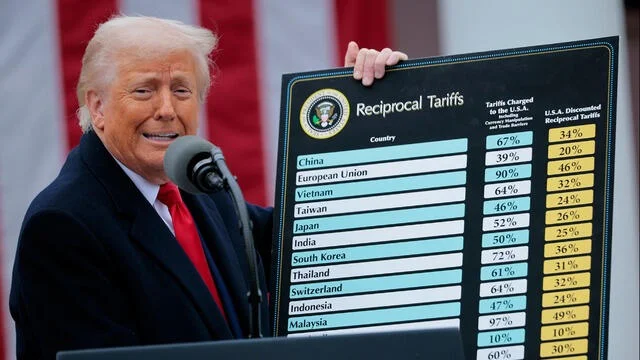Trump Announces Sweeping New Tariffs on “Liberation Day,” Sparking Economic Concerns

In a highly anticipated announcement, President Donald Trump revealed a new round of tariffs on foreign imports, branding April 2, 2025, as “Liberation Day.” This latest trade policy move sets a minimum 10% tariff on all imported goods and introduces higher, reciprocal tariffs on nations that impose trade restrictions on U.S. exports. Despite repeated warnings from economists about potential inflationary effects, the Trump administration is pushing forward with what it calls a bold stand against trade imbalances.
The new tariffs will be rolled out in two phases. The first, effective April 5, places a 10% baseline tariff on goods from all foreign countries. The second phase, beginning April 9, will see significantly higher tariffs on countries that impose their own barriers on U.S. goods. According to the White House, these reciprocal tariffs will be roughly half the rate of the tariffs those nations place on U.S. exports.
Countries Facing Higher Tariffs
Some of the world’s largest economies will face significantly higher tariff rates under Trump’s new trade policy. These increases are set to be additive, meaning they will be imposed on top of any previously existing tariffs. Among the hardest-hit nations are:
- China: 34%
- European Union: 20%
- Taiwan: 32%
- South Korea: 25%
- India: 26%
- Israel: 17%
While Canada and Mexico are currently exempt from these new tariff measures, they are still subject to existing Trump administration trade restrictions tied to migration and drug trafficking concerns.
Trump’s Justification for the Tariffs
Speaking in the White House Rose Garden, President Trump portrayed these measures as essential for restoring America’s economic independence. He claimed that previous administrations had allowed foreign nations to take advantage of the United States, leading to chronic trade deficits, weakened manufacturing, and national security risks.
“For too long, other countries have drained our wealth and weakened our industries. Those days are over. This is our declaration of economic independence,” Trump stated to an audience that included steelworkers, auto workers, and key members of his administration.
He emphasized that the United States’ reliance on imports for essential goods such as pharmaceuticals, electronics, and automobiles is a major vulnerability. According to Trump, these tariffs will incentivize companies to bring production back to American soil, reducing dependence on foreign suppliers.
The president also took aim at major U.S. trade partners, accusing them of unfair trade practices. He singled out Canada, the European Union, South Korea, and Australia, arguing that their trade policies unfairly hurt American farmers, ranchers, and manufacturers.
“They’ve taken so much of our wealth away from us,” Trump declared. “It’s time to stand up for American workers.”
Economic Reactions and Market Concerns
Despite the administration’s optimism, the announcement has triggered concerns among economists, financial analysts, and business leaders. Critics argue that while tariffs may benefit some domestic industries in the short term, they ultimately raise costs for consumers and businesses by making imported goods more expensive.
Stock markets have already shown signs of volatility in response to Trump’s tariff policies. Many economists predict that companies will pass the increased costs onto consumers, leading to higher prices for everything from cars and electronics to household goods and medical supplies.
Colin Grabow, an economist at the Cato Institute, warned that the tariffs could ultimately hurt the same American workers they aim to protect.
“Tariffs function as a tax on American consumers. While the administration claims these measures will strengthen the economy, they will lead to higher prices and strained trade relations,” Grabow wrote in a recent op-ed.
Others, including business coalitions and taxpayer advocacy groups, have expressed concerns that the new tariffs could harm U.S. manufacturers that rely on foreign materials. In a joint letter to congressional leaders, representatives from groups such as the National Taxpayers Union and Small Business & Entrepreneurship Council urged lawmakers to reconsider.
“We encourage policymakers to examine how tariffs on steel, lumber, energy, pharmaceuticals, and auto parts will increase costs for American businesses and consumers,” the letter stated.
Mixed Reactions from Labor Unions and Industry Groups
While many economists and financial experts oppose the tariffs, some labor unions and industry leaders have shown support, seeing them as a way to bring jobs back to the United States.
Shawn Fain, president of the United Auto Workers (UAW), defended the tariffs, stating that they could pressure corporations to reinvest in American workers.
“Tariffs are a tool to push companies to do the right thing. For decades, American workers have been left behind. These policies will help rebuild U.S. manufacturing and ensure good-paying jobs,” Fain said in an interview.
However, business groups and consumer advocacy organizations remain skeptical. Many argue that the tariffs could ultimately lead to price increases, making American-made products less competitive globally.
In response to concerns that higher tariffs would lead automakers to increase car prices, Trump dismissed the issue, telling NBC News, “I couldn’t care less if they raise prices, because people are going to start buying American-made cars.”
Uncertain Economic Outlook
The new tariffs mark a significant escalation in the Trump administration’s protectionist trade policies, which have defined much of his presidency. While supporters believe these measures will strengthen American manufacturing and create jobs, critics argue that they could trigger retaliatory tariffs from other nations, disrupt supply chains, and fuel inflation.
As the policies take effect, businesses, consumers, and financial markets will be watching closely to see how the U.S. economy responds to one of the most aggressive trade moves in recent history.
